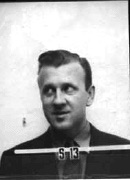Emil J. Konopinski (1911-1990) was an American theoretical physicist.
After receiving his Ph.D. from the University of Michigan, Konopinski worked as a National Research Council Fellow with Hans Bethe at Cornell University. In 1938, he accepted a position as a professor at Indiana University. After the outbreak of World War II, he joined Enrico Fermi‘s group at the University of Chicago Metallurgical Laboratory. He was a member of a theoretical study group set up by J. Robert Oppenheimer at the University of California, Berkeley in the summer of 1942. The group examined the principles of atomic bomb design and determined that a fission bomb was feasible, an important step in the progression of the Manhattan Project.
In addition to the Chicago Met Lab, Konopinski also worked at Los Alamos during the Project. He co-wrote a paper with Cloyd Marvin and Edward Teller that established that exploding fission or fusion weapons would not ignite the atmosphere and destroy the world. He has also been credited with suggesting that tritium be used in the design of the hydrogen bomb.
After the war, Konopinski returned to Indiana, where he taught for many years. He was a consultant for the U.S. Atomic Energy Commission and a Guggenheim Fellow, and authored several textbooks. He died on May 26, 1990.
Scientific Contributions
In his dissertation, Konopinski and his advisor George Uhlenbeck formulated the Konopinski-Uhlenbeck theory, an alternate to Fermi’s theory of beta radioactivity. He also co-developed the law of lepton conservation, and wrote the authoritative book The Theory of Beta Radioactivity.





